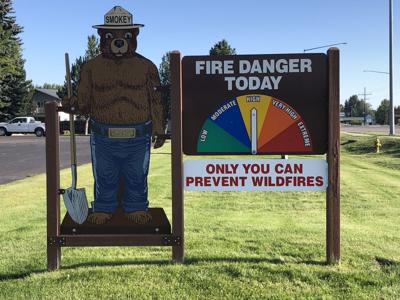We love forests, but each year we see larger and more severe fires and smoke. It threatens our lives. Municipal and agricultural watersheds, homes and infrastructure can be destroyed. Businesses lose income. Wildfires are by far the greatest cause of the loss of old growth.
Fire management officials recently briefed Gov. Greg Gianforte about the severity of the upcoming fire season. It will be drier and hotter now and into the fall. Canada’s wildfires already forced evacuations in two central prairie provinces. Smoke causes bad air quality in Canada and the U.S.

Fire danger level on the Bitterroot National Forest was raised from “moderate” back to “high” on July 1.
This crisis has been talked about and some action has been taken for decades, but we’re not moving fast enough or at a large enough scale. We know we need to thin forests and do prescribed burns. These actions work. Around our homes, we all need to maintain the “Home Ignition Zone.”
In 2024, a comprehensive study (including two Montana researchers) reviewed 40 individual studies where wildfires had encountered various types of fuel treatments and previous wildfires. Fuel treatments work!
Congress needs to provide adequate funding to do hazardous fuels reduction, vegetation management, mechanical and hand sawing, harvesting, and prescribed burning. Wildfires affect all of us regardless of party. Forest Service staffing and robust wildfire resilience funding are absolutely necessary.
Excess trees can be converted into valuable products, such as posts and poles. Sawmills and wood chip facilities are essential infrastructure for managing our forests.
Our current processes for planning and decision-making take too long. Agencies and private landowners have been managing fire for decades. We know the negative environmental, social and economic effects of large, severe fires are much worse than mechanical and prescribed fire treatments.
The Fix Our Forests Act (FOFA) was developed last year. It passed the House of Representatives with bipartisan support but did not pass the Senate. The House re-passed it in January. In April 2025, a companion version of FOFA was introduced in the Senate (S.1462) by two Republicans (including Sen. Sheehy) and two Democrats.
FOFA is useful because it establishes priority fire sheds, identifying the highest-risk areas based on fire potential, communities at risk, watersheds, and wildlife habitat. It establishes fire intelligence centers to support prescribed burning and wildfire management. Assessments include local, tribal and state governments to ensure public input.
To implement projects at scale and in a timely manner, the bill expands the size of Categorical Exclusions that the National Environmental Policy Act allows for when projects have been implemented routinely and the effects are well known.
FOFA provides for an accelerated process for judicial review, directing judges to consider the “balance of equities” between the plaintiffs and the public’s interest in reducing wildfire risk/damage. The public’s right to challenge decisions remains; FOFA just accelerates the process to be months instead of many years.
Forests capture carbon from the atmosphere. Using the trees removed instead of concrete and steel, helps us avoid the emissions from those products and continue to store the carbon in wood products.
Support FOFA and ask Congress to work to ensure appropriate resources and funding for the Forest Service so the legislation can be carried out as intended! See https://citizensclimatelobby.org/our-climate-solutions/healthy-forests.








(0) comments
Welcome to the discussion.
Log In
Keep it Clean. Please avoid obscene, vulgar, lewd, racist or sexually-oriented language.
PLEASE TURN OFF YOUR CAPS LOCK.
Don't Threaten. Threats of harming another person will not be tolerated.
Be Truthful. Don't knowingly lie about anyone or anything.
Be Nice. No racism, sexism or any sort of -ism that is degrading to another person.
Be Proactive. Use the 'Report' link on each comment to let us know of abusive posts.
Share with Us. We'd love to hear eyewitness accounts, the history behind an article.